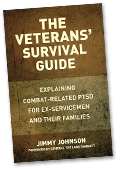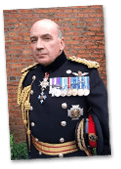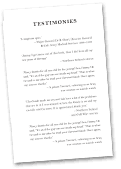To prevent promising careers and futures deteriorating into a living nightmare, it is important to realise that the onset of combat-related PTSD can begin immediately after trauma. However, it easily ‘masks’ itself and sufferers can remain totally unaware of their disorder for a lifetime, if undiagnosed. Even if they or their families seek the help they need, it is often too late to prevent serious consequences and relationship breakdowns.
Soldiers typically find themselves in life-threatening situations where they are expected to kill or be killed: life is deliberately taken through shootings, bombings, close-quarter combat, or violent acts. For some soldiers, these circumstances are experienced on a daily basis, and they are psychologically ‘hit’ again and again with raw and savage violence. If they are not physically injured in these events then they will ‘soldier on’, but tragically they often bring home this terror and carnage in their minds. Unfortunately, for some this madness can be instantly brought back into play by the normal stresses of civilian life, when the slightest everyday thing can act as a trigger to bring the disorder into being, without their knowledge.
Combat-related PTSD can be understood as a hidden psychological wound, and like all soldiers who survive wars and conflicts, some are wounded and some are not. Some wounds heal, some do not. If it is not identified and treated, then just like any other wound it might fester and become worse. With full-blown or severe PTSD, there is a higher chance that the person will also experience other symptoms, including anxiety, depression, fits of intense rage and anger, and thoughts of suicide. We all know that ‘if you are cut, you bleed’, and wounded veterans who are left undiagnosed and untreated continue to bleed. In time, their entire psychological universe can change, and their behaviour at home will become more erratic, while seeming perfectly normal to themselves – for it is the same behaviour that saved their lives while serving in conflicts
A veteran unknowingly suffering combat-related PTSD in Civvy Street is not living and thinking like a regular civilian – he is more like a machine. Each day, he exercises his coping skills by plotting and planning everything in his mind. He sticks to these plans rigorously, as he used to when following a drill, and problems can occur when he encounters tasks or obstacles that are not part of his programme. If a machine breaks down it can cause confusion, bewilderment and pressure. If a car backfires, or curtains move, suggesting snipers, then the resemblance to his experiences in conflict, however slight, can easily bring the symptoms of PTSD to the surface.
They say ‘water finds its own level’ as a reason for people getting along with each other in life, but if a veteran’s mind is processing different information to everyone around him, there is little chance of him carrying on normal relationships. Ultimately, he may lose his family, friends, colleagues and his job. All because nobody realises that he requires help to get past the trauma of the memories of conflict.
It is essential to catch combat-related PTSD at the earliest possible moment so that this disorder can be more easily treated, and the veteran can return to duties or resume a normal, productive life.
How the Mind Works
I will explain, in layman’s terms, how veterans’ behaviour is so deeply affected by their involvement in traumatic events, and why they unknowingly bring the horror back home with them. How and why I came across this information is explained in Chapter 6, Diagnosis, pages 115–24.
Try to imagine the mind as a very advanced computer system that records and stores all kinds of different information and knowledge onto a sort of brain ‘master disc’, also known as the subconscious. The mind needs the data that is stored on this ‘master disc’ to help people through each moment of their lives. In simple terms, if the brain wants or needs any information or knowledge, it immediately asks the subconscious for it. This process is as automatic and as vital as breathing. An example of how the subconscious works is when you can’t recollect someone’s name immediately but you suddenly remember it an hour later, or the following day or week: your subconscious has been independently and automatically searching through its archives, found the name requested, then fed the information back into your memory for you to remember it afresh.
It is in this way that the subconscious guides and steers people through their daily lives; it is what makes an individual who and what they are, it forms a person’s character and patterns their behaviour. However, when people become involved in horrific, abnormal and life-threatening situations, the subconscious becomes overwhelmed and cannot continue to register and neatly store away the destruction and violence in the usual way, as the facts are devastating and unacceptable. When the mind cannot process this hideous and terrifying data, it becomes stuck. If left untreated, these traumatic events will operate as sort of freewheeling, extra ‘hidden gears’ trapped in the veteran’s mind. These life-and-death incidents acting as volatile ‘hidden gears’ that ‘float’ in the subconscious make veterans suffering combat-related PTSD very vulnerable to ‘flashbacks’ and all sorts of misleading information when under pressure back on Civvy Street, often entirely without their knowledge
Tragically, the longer veterans processing combat related PTSD are left to cope with the unexpected pressures of everyday life in peacetime surroundings, the more the wounds of their subconscious bleed, feeding them false information of their past experiences and bringing their conflicts alive in everyday situations, with serious consequences for themselves and those around them.
For example, consider the following scenario. An ex-soldier and his wife are leaving the house one Saturday morning, when suddenly the next-door neighbour’s curtains move. The ex-soldier’s wife registers that the neighbours are up and about and thinks nothing more of it. For the ex-soldier, under stress and unknowingly suffering combat-related PTSD, seeing the curtains move signals a danger and a threat; his subconscious feeds him another mode of behaviour – one more appropriate to his role in the Army than his character as a civilian and a husband – and he starts to check all the windows and rooftops looking for snipers and gunmen, putting him on high alert and creating tense and strange behaviour beyond his knowledge or control.
To finish reading this chapter and the rest of the book, please click here to buy the book here.



